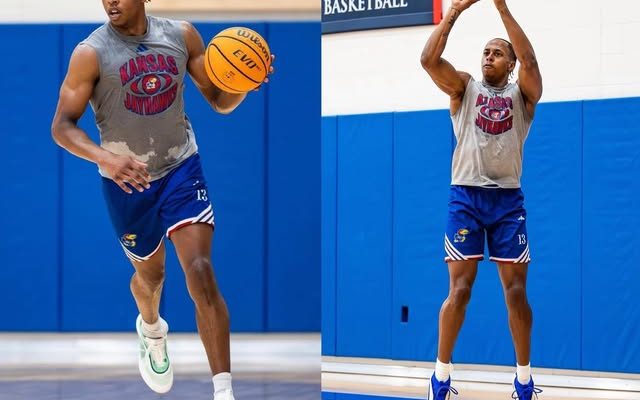In a moment of reassurance for Kansas Jayhawks basketball fans, head coach Bill Self made a declaration that resonated deeply across the college basketball landscape: Elmarko Jackson’s athleticism is officially back to the level it was at before the major injury he suffered last summer. For a program that prides itself on elite player development and for a fan base that has been waiting with bated breath to see Jackson fulfill his immense promise, this update could be the most significant storyline heading into the new season. More than just a routine injury recovery update, Self’s words suggest a potential turning point for a young player who once looked poised to be a breakout star before adversity stalled his ascent.
Elmarko Jackson’s arrival in Lawrence was met with an avalanche of excitement and expectation. A McDonald’s All-American, he carried the kind of reputation and pedigree that Kansas fans had grown accustomed to seeing translate into immediate impact. Built like a modern combo guard with elite burst, Jackson was known in high school for his ability to blow by defenders, rise up with explosion in traffic, and defend with tenacity on the perimeter. His high school film showed a player with an almost pro-level frame and a rare ability to change pace, a skill that separates great guards from merely good ones. His recruitment was nationally followed, with top programs like UConn, Miami, and Texas expressing strong interest before he ultimately chose Kansas and the tutelage of Self.
Unfortunately, his college trajectory hit a major snag when he suffered a significant injury during offseason workouts in the summer of 2024. The injury, while not widely disclosed in exact detail, was enough to sideline Jackson for most of his preseason training, limit his availability early in the season, and hinder his explosiveness well into the winter. Observers noted that while Jackson was seeing some minutes off the bench, he lacked the same bounce and change-of-direction fluidity that had made him a terror on the high school circuit. Rather than a dynamic spark plug, Jackson looked tentative, reactive rather than assertive, and his minutes were often sporadic as a result. There were flashes—breakaway dunks in transition, glimpses of perimeter defense that reminded people why he was a five-star recruit—but they were intermittent and lacked consistency.
For Coach Bill Self, who has coached NBA-level talent year after year, this kind of developmental bump is not unusual. But even for a seasoned coach, managing a young player’s psyche through injury, rehabilitation, and reduced minutes is a delicate process. In that context, Self’s recent comment that Elmarko’s athleticism is back to where it was before the injury is more than just coach-speak—it’s a message to the program, to NBA scouts, and most importantly, to Jackson himself. He’s back. And perhaps more crucially, he’s ready.
Injuries are, unfortunately, a brutal reality in sports, and they have a unique way of derailing momentum. For a freshman like Jackson, who was expected to be a rotational player if not a starter during his first season, the timing could not have been worse. The adjustment from high school to college basketball is already a daunting one. The speed, physicality, and complexity of the college game often overwhelm even the most talented high school players. Add to that the psychological toll of a major injury—missing reps, lagging behind in conditioning, watching from the sidelines as peers adapt and improve—and it’s easy to understand how even the brightest careers can be stalled before they begin. Jackson’s first season at Kansas reflected this reality. He was present, but not entirely himself.
Despite that, the coaching staff never wavered in their long-term belief in Jackson’s potential. Assistant coaches routinely praised his work ethic in rehab, his willingness to be coached, and his patience as he waited for his body to catch up to his mind. The modern era of college basketball, especially with the transfer portal providing instant gratification elsewhere, makes it easy for young players to jump ship when things don’t go perfectly. Jackson didn’t do that. He stuck with the program, trusted the staff, and embraced the grind of recovery. In doing so, he earned not just the respect of the coaching staff, but also the locker room.
The anticipation surrounding Jackson’s bounceback season is rooted not just in hope but in observable data. Throughout spring workouts and early summer practices, coaches and insiders have noted his vertical pop has returned, his lateral quickness is back, and perhaps most critically, his confidence is visibly higher. Teammates have talked about how Jackson is attacking the rim with purpose, staying low on defense, and no longer favoring the leg that had once limited his movements. His shooting form has also improved, a likely byproduct of better balance and restored lower body strength. In short, he’s looking more like the player Kansas thought they were getting when they beat out powerhouse programs for his signature.
Kansas, as a program, is entering a transitional phase in 2025. With key veterans having moved on and a new crop of talent incoming, there is a need for someone like Jackson to step into a leadership role—not necessarily as a senior voice in the locker room, but as a tone-setter on the floor. His athleticism, when fully operational, can tilt games. He has the kind of two-way impact that’s hard to come by: a player who can pressure the ball full court and then finish with flair in transition, or who can collapse a defense with a first step and then kick out to shooters. Self’s system has always rewarded guards who can both distribute and defend, and Jackson, with his physical gifts and emerging maturity, is primed to be that kind of weapon.
More than that, his story has the makings of a classic college basketball arc—the high-profile recruit who endures early hardship, recommits, and then re-emerges as a force. That kind of resilience resonates not just with fans but with NBA scouts as well. The professional game is filled with athletic marvels, but teams are always on the lookout for players who’ve faced adversity and grown from it. Jackson now enters this season not as an unproven rookie, but as a sophomore with something to prove—a chip on his shoulder, sure, but also a clarity of purpose that only comes from struggle. If he stays healthy, there’s no reason to believe he can’t be one of the biggest breakout players in the Big 12 this season.
For Kansas, having Jackson at full strength adds an entirely new dimension to their backcourt. While they have other capable guards and emerging wings, no one else brings the same combination of burst, length, and defensive disruption. His presence could allow Self to implement more full-court pressure, switch defensively across positions, and push the pace in transition. He’s the kind of player who can guard multiple spots, finish above the rim in traffic, and inject energy when the offense gets stagnant. And now that he’s no longer playing on a compromised leg, the coaching staff can afford to let him off the leash a bit more.



